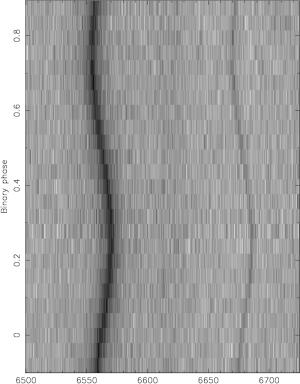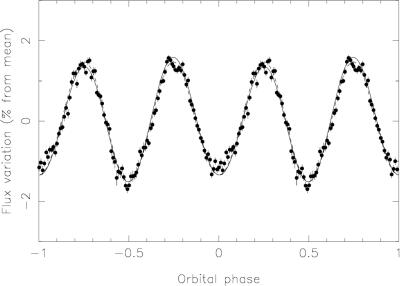- Billères, M., Fontaine, G., Brassard, P., Charpinet, S., Liebert, J., Saffer, R. A., 2000, ApJ, 530, 441.
- Riess et al., 1998, AJ, 116, 1009.
- Leibundgut, B., 2000, A&AR, in press (astro-ph/0003326).
- Perlmutter et al., 1999, ApJ, 517, 565.
- Saffer, R. A., Livio, M., Yungelson, L. R., 1998, ApJ, 502, 394.
| THE ING NEWSLETTER | No. 3, September 2000 |
|
|
SCIENCE |
|
|
|
| Previous: | Ultra-Deep Imaging at the William Herschel Telescope | Up: | Table of Contents | Next: | WHT Measures Speed of Surface Vibrations on Stellar Corpses |
Other available formats: PDF | gzipped Postscript
Discovery of a Type Ia Supernova Progenitor
P. F. L. Maxted, R. C. North and T. R. Marsh (University of Southampton, Department of Physics and Astronomy)
In April of this year we were awarded 13 nights of INT time to look for binary subdwarf-B (sdB) stars. The properties of these stars strongly suggest they are composed almost entirely of helium and have masses close to 0.5 solar masses (Saffer et al., 1998). We suspected that many of these stars would be short period binary stars, and we were right. We found 22 binary stars from a sample of 42 sdB stars from the Doppler shifts in the H-alpha line, only one or two of which were previously known. However, despite this important result, this observing run will be remembered for the two hours we spent observing one particular sdB star, KPD1930+2752, because it turned out that this star could be an important step in answering some of the biggest questions in observational cosmology.
We decided to observe KPD1930+2752 because a paper appeared by Billères et al. (2000) presenting photometry of this star suggested it is a binary with an orbital period of only 2h17m. The photometry was taken to look for pulsations with periods of a few hundred seconds, a phenomenon now observed in several other sdB stars. Pulsations were detected in KPD1930+2752, but superimposed on the complex multi-periodic pulsations is a quasi-sinusoidal signal with a period of about an hour. Folding the data on twice this period shows the typical light curve of a star distorted by the presence of a close companion, i.e., an ellipsoidal variation with two maxima and two unequal minima. To confirm this interpretation, radial velocity measurements were needed to look for the Doppler shift of the star as it orbits its unseen companion star. We were in an ideal position to make these observations, so we observed KPD1930+2752 over one orbit on the morning of April 17th.
The expected radial velocity shift
is very easily seen in the raw data (Figure 1) and
shows the sinusoidal shape expected for a circular orbit. What is surprising
is the large amplitude of the motion (350km/s). KPD1930+2752 is a very
typical sdB star with a mass close to 0.5 solar masses so the mass of the
companion must be at least 0.97 solar masses. A normal star of this mass
is too large to fit into such a short period binary, so the companion is
almost certainly a white dwarf star. If we assume the orbital plane of
the binary is edge-on to our line-of-sight, we can predict the size of
the ellipsoidal variation we should see based on our measured radial velocity
amplitude, the measured surface gravity of the sdB star and the orbital
period. This gives a very good fit to the observed light curve (Figure
2), so the inclination must be close to this assumed value and the
mass of the white dwarf is not much higher than the minimum value of 0.97
solar masses. A white dwarf of this mass are thought to be composed of
degenerate carbon and oxygen.
 |
 |
|
|
|
Massive white dwarfs in binaries are prime candidates for the progenitors of Type Ia supernovae. The observed properties of Type Ia supernovae put very strong constraints on the progenitors, particularly the complete absence of hydrogen and helium in the spectrum just after the explosion and their appearance in old stellar populations such as elliptical galaxies. Models of exploding white dwarfs are, naturally, very uncertain, but it appears likely that a massive white dwarf composed of carbon and oxygen will explode if it accumulates a layer of helium and then exceeds the Chandrasekhar limit. A proposed mechanism for build-up of helium on a massive white dwarf is steady thermonuclear burning of hydrogen due to accretion from a normal star. The observed counterparts to these binaries are the 'super-soft sources' which are identified by the soft X-ray flux emanating from the hot surface of the white dwarf. However, it appears that the majority of Type Ia supernova cannot be due to super-soft sources because the mass transfer rate must remain within a narrow range for a sufficiently long time to build up sufficient helium. At lower accretion rates the hydrogen does not burn steadily, but is ejected in a series of nova explosions. At higher accretion rates the mass transfer is Eddington-limited. It also appears that super-soft sources are not sufficiently long-lived to give supernova explosions in elliptical galaxies (Leibundgut, 2000).
The competing model to super-soft sources has been the double degenerate scenario, in which the companion to the massive white dwarf is a lower mass white dwarf composed mostly of helium. In this scenario, the mass transfer occurs when gravitational radiation drives the two white dwarfs into contact. The difficulty with this model has been the lack of any observed counterparts. This is not surprising given that only 1 in 500 white dwarfs needs to be a progenitor to explain the observed rate of galactic supernovae and far fewer than 500 white dwarfs have been studied in sufficient detail to reveal whether they are potential supernovae.
The possibility of a helium star companion to a white dwarf has not been widely considered as a source of Type Ia supernovae, but KPD1930+2752 is clearly a very promising candidate. Gravitational radiation will drive the sdB star and the white dwarf together within 200 million years, at which point the white dwarf will accrete the sdB star and exceed the Chandrasekhar mass. The result of our search for binary sdB stars becomes important in this regard because many of them will have white dwarf companions, though not all will be as massive as the companion to KPD1930+2752. We intend to continue our observations of these stars to determine the companion mass distribution and the period distribution. The space density of sdB stars is quite well determined, so we will then be able to say whether there are enough binaries like KPD1930+2752 to explain the observed rate of Type Ia supernovae in our Galaxy.
The true nature of Type Ia supernovae has become an important question for observational cosmology because they are used as standard candles and can be observed at redshift as high as z~1. Observations of these distant supernovae has recently led to claims that the expansion of the Universe is accelerating (Riess et al., 1998, Perlmutter et al., 1999). This conclusion is the result of Type Ia supernovae at high redshift being about 30% too bright compared to a non-accelerating Universe model. This has led to intense debate over the possibility that the properties of Type Ia supernovae has evolved so as to mimic an accelerating Universe. A clear answer to this question will not be possible until the identity of the progenitors is determined. The discovery of KPD1930+2752 is an important step in our understanding of this most fundamental question.
References:
Email contact: Pierre Maxted (pflm@astro.soton.ac.uk)
| Previous: | Ultra-Deep Imaging at the William Herschel Telescope | Up: | Table of Contents | Next: | WHT Measures Speed of Surface Vibrations on Stellar Corpses |
| GENERAL | SCIENCE | TELESCOPES AND INSTRUMENTATION | OTHER NEWS FROM ING | TELESCOPE TIME |